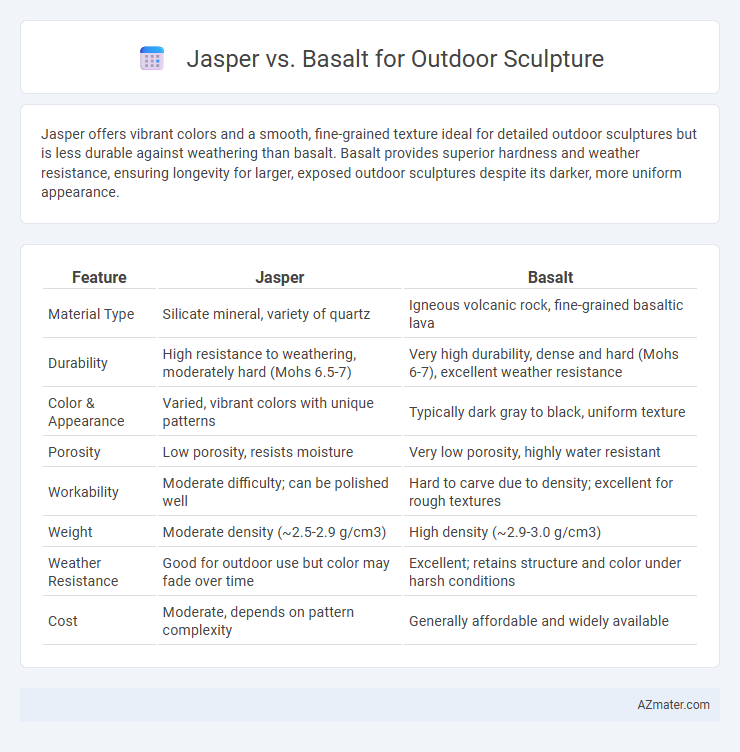Jasper offers vibrant colors and a smooth, fine-grained texture ideal for detailed outdoor sculptures but is less durable against weathering than basalt. Basalt provides superior hardness and weather resistance, ensuring longevity for larger, exposed outdoor sculptures despite its darker, more uniform appearance.
Table of Comparison
| Feature | Jasper | Basalt |
|---|---|---|
| Material Type | Silicate mineral, variety of quartz | Igneous volcanic rock, fine-grained basaltic lava |
| Durability | High resistance to weathering, moderately hard (Mohs 6.5-7) | Very high durability, dense and hard (Mohs 6-7), excellent weather resistance |
| Color & Appearance | Varied, vibrant colors with unique patterns | Typically dark gray to black, uniform texture |
| Porosity | Low porosity, resists moisture | Very low porosity, highly water resistant |
| Workability | Moderate difficulty; can be polished well | Hard to carve due to density; excellent for rough textures |
| Weight | Moderate density (~2.5-2.9 g/cm3) | High density (~2.9-3.0 g/cm3) |
| Weather Resistance | Good for outdoor use but color may fade over time | Excellent; retains structure and color under harsh conditions |
| Cost | Moderate, depends on pattern complexity | Generally affordable and widely available |
Overview: Jasper and Basalt in Outdoor Sculpture
Jasper and basalt are both popular materials for outdoor sculpture due to their durability and aesthetic qualities. Jasper, a form of chalcedony, is prized for its rich color variations and smooth finish, making it ideal for detailed and vibrant artwork exposed to natural elements. Basalt, a dense volcanic rock, offers exceptional strength and weather resistance, providing sculptures with long-lasting structural integrity and a rugged, natural appearance.
Geological Origins and Characteristics
Jasper, a microcrystalline variety of quartz formed through sedimentary or volcanic processes, is prized for its hardness and vibrant colors resulting from iron inclusions. Basalt, an extrusive igneous rock formed from rapid cooling of lava at Earth's surface, is dense and fine-grained with excellent durability against weathering. Both materials offer robust options for outdoor sculpture, with jasper providing aesthetic diversity and basalt ensuring structural longevity.
Aesthetic Qualities and Color Variations
Jasper offers a rich palette of warm earth tones, including reds, browns, and yellows, which impart a vibrant, organic aesthetic to outdoor sculptures. Basalt, with its deep gray to black hues and fine-grained texture, provides a sleek, modern look that emphasizes form and shadow. Both stones exhibit excellent durability outdoors, but jasper's varied colors create dynamic visual interest, while basalt's uniformity enhances minimalist design.
Durability and Weather Resistance
Basalt offers superior durability and weather resistance compared to jasper, making it highly suitable for outdoor sculptures exposed to varying climates. Its dense, fine-grained volcanic origin provides excellent resistance to erosion, freeze-thaw cycles, and UV radiation, ensuring long-lasting structural integrity. Jasper, while visually striking with vibrant colors, is more prone to surface weathering and chipping in harsh environmental conditions.
Workability: Carving and Shaping
Jasper offers moderate workability for outdoor sculpture due to its fine grain and hardness, allowing detailed carving but requiring specialized tools to shape effectively. Basalt, being a dense volcanic rock with a coarse texture and high hardness, presents significant challenges in carving and shaping, often demanding heavy-duty equipment and advanced techniques. Sculptors favor jasper for intricate designs and basalt for bold, durable forms in outdoor settings.
Maintenance Requirements
Jasper requires minimal maintenance for outdoor sculptures due to its high hardness and resistance to weathering, ensuring long-lasting durability with occasional cleaning. Basalt, while also durable and resistant to environmental elements, may need more frequent inspections to prevent surface erosion or moss buildup in humid climates. Regular maintenance of both materials involves cleaning with mild detergents and avoiding harsh chemicals to preserve their natural texture and appearance.
Cost and Availability Comparison
Jasper and basalt differ significantly in cost and availability for outdoor sculpture projects, with basalt typically being more affordable due to its abundance and widespread quarrying, especially in volcanic regions. Jasper, a semi-precious stone known for its vibrant colors and patterns, is rarer and often commands higher prices, making it less accessible for large-scale outdoor sculptures. The choice between the two materials depends largely on budget constraints and desired aesthetic, with basalt offering a cost-effective, durable option and jasper providing unique visual appeal at a premium price point.
Suitability for Large-Scale Installations
Basalt's dense, durable composition and resistance to weathering make it highly suitable for large-scale outdoor sculptures, offering long-term structural integrity and minimal maintenance. Jasper, while visually striking with its rich colors and patterns, is generally less durable in harsh outdoor environments and may require more frequent conservation efforts. For monumental installations demanding durability and weather resistance, basalt is often the preferred choice in outdoor art projects.
Notable Examples of Jasper and Basalt Sculptures
Jasper sculptures like the iconic "The Thinker" by Auguste Rodin showcase the stone's rich colors and smooth texture, ideal for detailed outdoor art. Basalt's durability is exemplified in monumental works such as the Olmec Colossal Heads, which highlight its resilience and ability to withstand harsh outdoor environments. Both materials offer unique aesthetic and structural qualities that define their use in notable public sculptures worldwide.
Choosing the Right Stone for Outdoor Art
Jasper offers vibrant colors and intricate patterns ideal for visually striking outdoor sculptures, while basalt provides exceptional durability and weather resistance for long-lasting installations. Choosing the right stone depends on the desired aesthetic impact and environmental exposure, with basalt excelling in harsh climates due to its dense, volcanic composition. Sculptors must balance artistic intent with maintenance considerations to ensure the longevity and visual appeal of outdoor art.

Infographic: Jasper vs Basalt for Outdoor Sculpture
 azmater.com
azmater.com